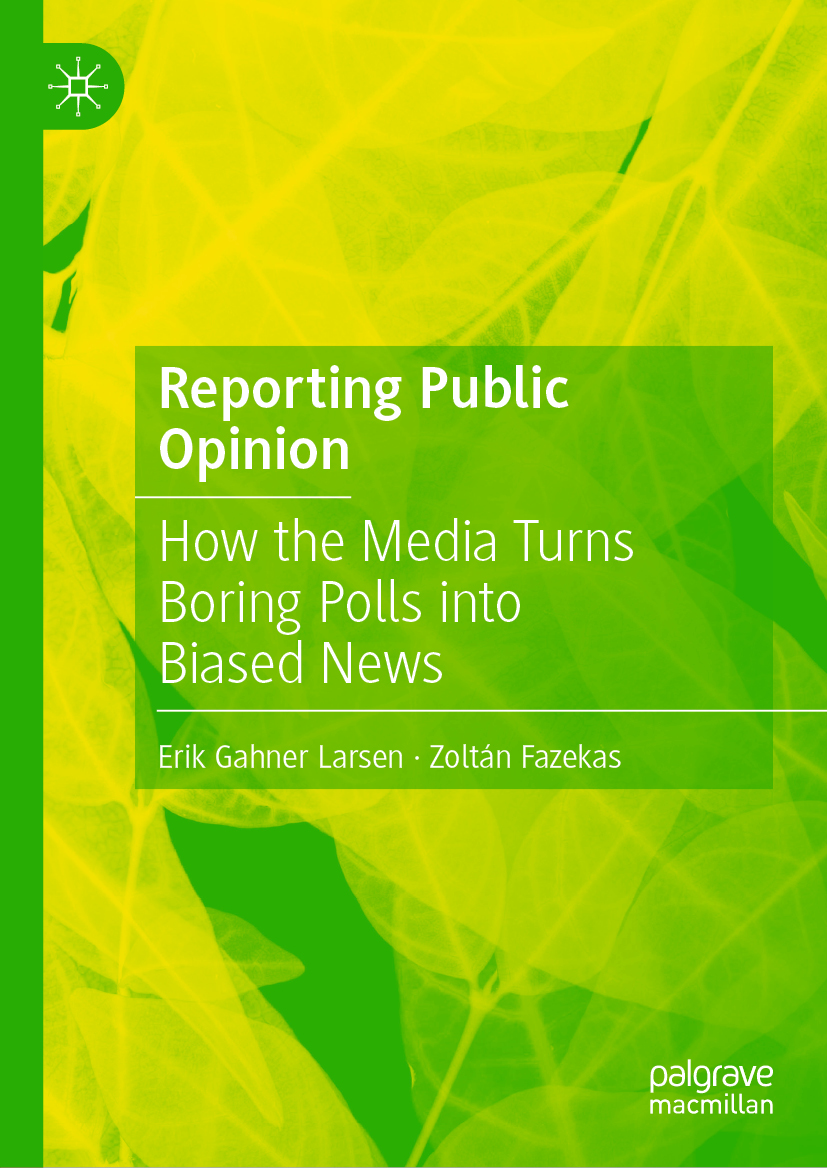 I am happy to announce the publication of a new book, ‘Reporting Public Opinion: How the Media Turns Boring Polls into Biased News‘, co-authored with Zoltán Fazekas. The book is about how and why opinion polls are more likely to be about change in the news reporting. Specifically, journalists are more likely to pick opinion polls that show changes, even when such changes are within the margin of error, highlight such changes in the reporting – and the public, pundits and politicians are more likely to respond to and share such polls.
I am happy to announce the publication of a new book, ‘Reporting Public Opinion: How the Media Turns Boring Polls into Biased News‘, co-authored with Zoltán Fazekas. The book is about how and why opinion polls are more likely to be about change in the news reporting. Specifically, journalists are more likely to pick opinion polls that show changes, even when such changes are within the margin of error, highlight such changes in the reporting – and the public, pundits and politicians are more likely to respond to and share such polls.
Here is the puzzle we address throughout the various chapters: how can most opinion polls show a lot of stability over short periods of time whereas the reporting of opinion polls are dominated by change?
Even for the most hardcore followers of politics, opinion polls are quite boring in and by themselves. In most cases they show nothing new. When we take the margin of error into account, a new opinion poll will most likely show that there is no statistically significant shift in the polls for any of the political parties of interest. And when there is a large change, it is most likely a statistical fluke we should be cautious about. I have over the years written countless posts about such opinion polls being covered in the Danish media.
The book is our attempt to provide a unified framework to better understand these dynamics in a systematic manner. In the first chapter of the book, we introduce the theoretical puzzle and outline the main limitation of existing studies on the topic, namely that studies on opinion polls tend to focus on one specific stage in the coverage, such as whether methodological details are present in the coverage or not. To fully understand how opinion polls are covered and consumed in contemporary democracies, we argue that we need to combine different literatures on opinion polls and examine how a strong preference for change can explain biases in how opinion polls travel through several stages from their initial collection to how they reach the public.
In the second chapter, we further develop a framework that focuses on the temporal dimension of how opinion polls are brought to the public via the media. This chapter serves as an introduction to the four stages that opinion polls have to go through in our framework. Specifically, we show how each stage – or activity – will lead to polls showing greater changes getting more attention. This is illustrated below:

Next, throughout Chapters 3, 4, and 5, we cover the stages of opinion polls in greater detail and show collectively how opinion polls are being turned into specific news stories. In Chapter 3, we focus on the selection of opinion polls. That is, we investigate what can explain whether journalists decide to cover an opinion poll or not. In Chapter 4, we target the content of the reporting of opinion polls, which covers the news articles dedicated to the opinion polls that journalists have decided to report on. In doing this, we show how the selection and reporting of opinion polls are shaped by a similar preference for change. Noteworthy, when introducing the idea of change, we dedicate extensive considerations to how we can best measure change and what the availability of these change measures means for the selection and reporting.
In Chapter 5, we analyse the next natural stage in the life of opinion polls: how do politicians, experts and the public respond to them and to the stories written about them. Essentially, we delve into the implications of how these opinion polls are selected and covered. Here, we show that both elites and the broader public have a strong preference to engage with (respond to or share) opinion polls that show greater changes or support a well-defined change narrative. Interestingly, we find that opinion polls showing greater changes are much more likely to go viral on Twitter.
In Chapter 6, we turn our attention to the alternatives of the reporting of opinion polls. Here, we discuss how no opinion polls at all, poll aggregators, social media, and vox pops can be seen as alternatives to opinion polls, and in particular what are their strengths and limitations. The ambition here is not to force the reader to decide whether opinion polls are good or bad, but rather to understand how alternatives to opinion polls can mitigate or amplify the biases introduced in the previous chapter.
Last, in Chapter 7, we conclude how the media might report on opinion polls by considering the trade-offs between what the polls often show and what journalists wish they showed. Specifically, we first set out to discuss the implications of the findings for how we understand the political coverage of opinion polls today and then discuss the most important questions to be answered in future work.
The book is the product of years of work on the topic of how opinion polls are reported in the media. However, while the topic should be of interest to most people with an interest in politics and opinion polls, this is an academic book and I should emphasise that it might be a tough read for a non-academic audience.
You can buy the book at Waterstones, Bookshop, Springer, Blackwell’s and Palgrave.